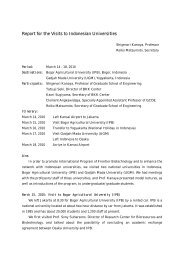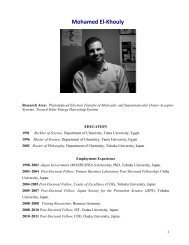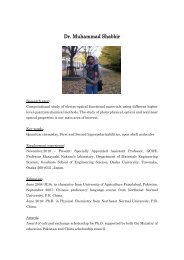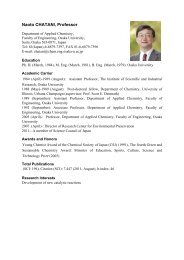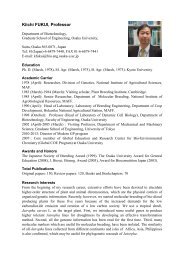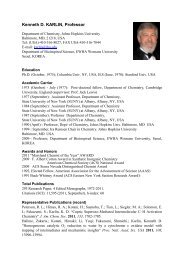Prof. Hayashi - Osaka University
Prof. Hayashi - Osaka University
Prof. Hayashi - Osaka University
You also want an ePaper? Increase the reach of your titles
YUMPU automatically turns print PDFs into web optimized ePapers that Google loves.
Takashi HAYASHI, <strong>Prof</strong>essor<br />
Department of Applied Chemistry,<br />
Graduate School of Engineering, <strong>Osaka</strong> <strong>University</strong>,<br />
Suita, <strong>Osaka</strong> 565-0871, Japan<br />
Tel: 81(Japan)-6-6879-7928, FAX 81-6-6879-7930<br />
E-mail: thayashi@chem.eng.osaka-u.ac.jp<br />
Education<br />
Ph. D. (March, 1990), M. Eng. (March, 1987), B. Eng. (March, 1985): Kyoto <strong>University</strong><br />
Academic Carrier<br />
1990 (April) – 1997 (June): Assistant <strong>Prof</strong>essor, Department of Synthetic Chemistry and<br />
Biological Chemistry, Faculty of Engineering, Kyoto <strong>University</strong><br />
1995 (August) – 1996 (September): Visiting Scientist, Department of Chemistry, The Scripps<br />
Research Institute<br />
1977 (July) – 2005 (March): Associate <strong>Prof</strong>essor, Department of Chemistry and<br />
Biochemistry, Kyushu <strong>University</strong><br />
2000 (October) – 2003 (September): Project Leader on Precursory Research for Embryonic<br />
Science and Technology in JST (PREST)<br />
2005 (April) – : <strong>Prof</strong>essor, Department of Applied Chemistry, Faculty of Engineering, <strong>Osaka</strong><br />
<strong>University</strong><br />
2005 (April) – 2007 (March): Visiting <strong>Prof</strong>essor, Institute of Molecular Science<br />
2010: Visiting <strong>Prof</strong>essor, Department of Chemistry, <strong>University</strong> of Strasbourg<br />
Awards and Honors<br />
Kaneka Corporation Award in Synthetic Organic Chemistry (1992), Inoue Research Award<br />
for Young Scientists (1992), The Progress Award on Synthetic Organic Chemistry, Japan<br />
(2000), 1st Young Investigator Award in Porphyrin Chemistry (2000), 2001 Kyushu<br />
<strong>University</strong> President Award (2002), 7th Research Promoted Award on Enzyme Application<br />
supported by Amano Enzyme Inc. (2006), Bull. Chem. Soc. Jpn. Award (2008), The Chemical<br />
Society of Japan (CSJ) Award for Creative Work (2010), The <strong>Osaka</strong> <strong>University</strong> Award for<br />
Research and Education (2011).<br />
Total Publications<br />
approximately 100 original papers and 6 book chapters<br />
Research Interests<br />
1) Synthesis, Structure and Reactivity of Porphyrins and Metalloporphyrins<br />
2) Hemoproteins Reconstituted with Non-natural Prosthetic Groups<br />
3) Modification of Metalloproteins<br />
4) Elucidation of Molecular Mechanism of Hemoproteins<br />
5) Supramolecular Self-Assembly of Proteins<br />
6) Construction of Artificial Metalloenzyme
Modification and Functionalization of Hemoproteins<br />
Takashi <strong>Hayashi</strong><br />
1 Department of Applied Chemistry, Graduate School of Engineering, <strong>Osaka</strong> <strong>University</strong>, Suita,<br />
<strong>Osaka</strong> 565-0871, Japan<br />
thayashi@chem.eng.osaka-u.ac.jp<br />
A series of hemoproteins has one or several heme prosthetic groups within their interiors.<br />
It is well-known that these proteins perform a variety of functions in biological systems, such<br />
as dioxygen storage and transfer, catalysis, electron-transfer, and gas sensing, due to the<br />
versatile reactivity of heme, iron porphyrin. Particularly, the typical prosthetic group is<br />
protoheme IX which is bound in the protein pocket via non-covalent and coordination<br />
interactions. Thus, it is possible to replace native heme with a modified metal complex as<br />
shown in the following Figure. Our group has recently focused on the reconstitution of<br />
hemoproteins with an artificial prosthetic group to obtain a functionalized protein. 1 In this<br />
presentation, our three topics will be presented.<br />
(i) Introduction of some functional groups into the termini of the heme-propionate side chains<br />
to construct an artificial interface on the protein surface: For example, the interface acts as a<br />
substrate-binding site near the heme pocket in myoglobin, and the peroxidase activity of the<br />
reconstituted myoglobin was close to that of horseradish peroxidase (HRP). 2<br />
(ii) Replacement of native heme with an artificial metalloporphyrinoid: Myoglobin and HRP<br />
reconstituted with iron porphycene, a constitutional isomer of heme, showed dramatically<br />
enhanced dioxygen affinity and peroxidase activity, respectively. 3<br />
(iii) Supramolecular hemoprotein self-assembly by interprotein interaction between an<br />
external heme and heme pocket to create new bionanomaterials: Heme moiety was<br />
introduced onto the hemoprotein surface via covalent linkage and the following removal of<br />
native heme from the heme pocket provided a successive hemoprotein array with the length of<br />
200–800 nm including 50–200 proteins. 4 Furthermore, the hemoprotein layer on a gold<br />
surface and gold nanoparticle self-assembly are found to be available by use of the strategy of<br />
the hemoprotein assembly. 5<br />
These methods will serve as a new way to prepare a functional device using metalloprotein<br />
materials.<br />
(1) <strong>Hayashi</strong>, T. In Handbook of Porphyrin Science; Kadish, K. M.; Smith, K. M.; Guilard, R. Eds.; World Scientific<br />
Publishing: Singapore, 2010; Vol. 5, pp 1–69.<br />
(2) Matsuo, T.; Fukumoto, K.; Watanabe, T.; <strong>Hayashi</strong>, T. Chem. Asian, J. 2011, 6, 2491–2499.<br />
(3) (a) Matsuo, T.; Murata, D.; Hisaeda, Y.; Hori, H. <strong>Hayashi</strong>, T. J. Am. Chem. Soc. 2007, 129, 12906–12907, (b) Matsuo,<br />
T.; <strong>Hayashi</strong>, A.; Abe. M.; Matsuda, T.; Hisaeda, Y.; <strong>Hayashi</strong>, T. J. Am. Chem. Soc. 2009, 131, 15124–15125.<br />
(4) (a) Kitagishi, H.; Oohora, K.; Yamaguchi, H.; Sato, H.; Matsuo, T.; Harada, A.;. <strong>Hayashi</strong>, T. J. Am. Chem. Soc. 2007,<br />
129, 10326–10327. (b) Kitagishi, H.; Kakikura, Y.; Yamaguchi, H.; Oohora, K.; Harada, A.; <strong>Hayashi</strong>, T. Angew. Chem. Int.<br />
Ed. 2009, 48, 1271–1274. (c) Oohora, K.; Onoda, A.; Kitagishi, H.; Harada, A.; <strong>Hayashi</strong>, T. Chem. Sci. 2011, 2, 1033–1038.<br />
(5) (a) Onoda, A.; Ueya, Y.; Sakamoto, T.; Uematsu, T.; <strong>Hayashi</strong>, T. Chem. Commun. 2010, 46, 9107–9109, (b) Onoda, A.;<br />
Kakikura, Y.; Uematsu, T.; Kuwabata, S.; <strong>Hayashi</strong>, T. Angew. Chem. Int. Ed. in press.



